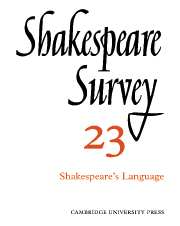Book contents
- Frontmatter
- Shakespeare and the Tune of the Time
- Some Functions of Shakespearian Word-formation
- Guide-lines for Interpreting the Uses of the Suffix ‘-ed’ in Shakespeare’s English
- Shakespeare’s Use of Colloquial Language
- Words, Action, and Artistic Economy
- ‘Antony and Cleopatra’: the Limits of Mythology
- Shakespeare’s ‘War with Time’: the Sonnets and ‘Richard II’
- Shakespeare and Christian Doctrine: Some Qualifications
- Shakespeare’s Poets
- The Text of Coleridge’s 1811–12 Shakespeare Lectures
- Shakespeare Studies in German: 1959–68
- A Neglected Jones/Webb Theatre Project: ‘Barber-Surgeons’ Hall Writ Large
- Interpretation or Experience? Shakespeare at Stratford
- 1 Critical Studies
- 2 Shakespeare’s Life, Times, and Stage
- 3 Textual Studies
- Index
- Plate section
Some Functions of Shakespearian Word-formation
Published online by Cambridge University Press: 28 March 2007
- Frontmatter
- Shakespeare and the Tune of the Time
- Some Functions of Shakespearian Word-formation
- Guide-lines for Interpreting the Uses of the Suffix ‘-ed’ in Shakespeare’s English
- Shakespeare’s Use of Colloquial Language
- Words, Action, and Artistic Economy
- ‘Antony and Cleopatra’: the Limits of Mythology
- Shakespeare’s ‘War with Time’: the Sonnets and ‘Richard II’
- Shakespeare and Christian Doctrine: Some Qualifications
- Shakespeare’s Poets
- The Text of Coleridge’s 1811–12 Shakespeare Lectures
- Shakespeare Studies in German: 1959–68
- A Neglected Jones/Webb Theatre Project: ‘Barber-Surgeons’ Hall Writ Large
- Interpretation or Experience? Shakespeare at Stratford
- 1 Critical Studies
- 2 Shakespeare’s Life, Times, and Stage
- 3 Textual Studies
- Index
- Plate section
Summary
Many critics of Shakespeare’s style have commented on his lexical innovations, but only too often exemplification has consisted of random listing where neologisms such as bare-faced, countless, distrustful, dog-weary, ensconce, fancy-free, ill-got, lack-lustre and crop-ear have been quoted without any analysis of the patterns on which they were formed, the underlying grammatical relationships in the compounds or the purposes for which they were coined. Some scholars have discussed the characteristics of Shakespeare’s diction in general, without distinguishing his neologisms; others have concerned themselves with individual methods of word-formation, such as functional conversion, or have investigated the effect of particular neologisms to the neglect of general linguistic considerations. At the other extreme, Franz’s grammar lists all the types of word-formation exemplified in Shakespeare’s usage, but without providing any guidance, except casually, on the extent of their originality or their purpose, while in another comprehensive work, Jespersen’s grammar of post-medieval English, Shakespearian examples are quoted only as incidental items in a general survey. The lack of any reasoned account of the principles directing Shakespeare’s lexical creativity has led to the kind of vague, subjective assessment of its nature and purpose which characterizes certain neologisms in Troilus and Cressida, including conflux, protractive, persistive, appertainments, soilure and embrasures, as ‘strange and shapeless, fashioned for argument rather than delight...
- Type
- Chapter
- Information
- Shakespeare Survey , pp. 13 - 26Publisher: Cambridge University PressPrint publication year: 1970
- 1
- Cited by

